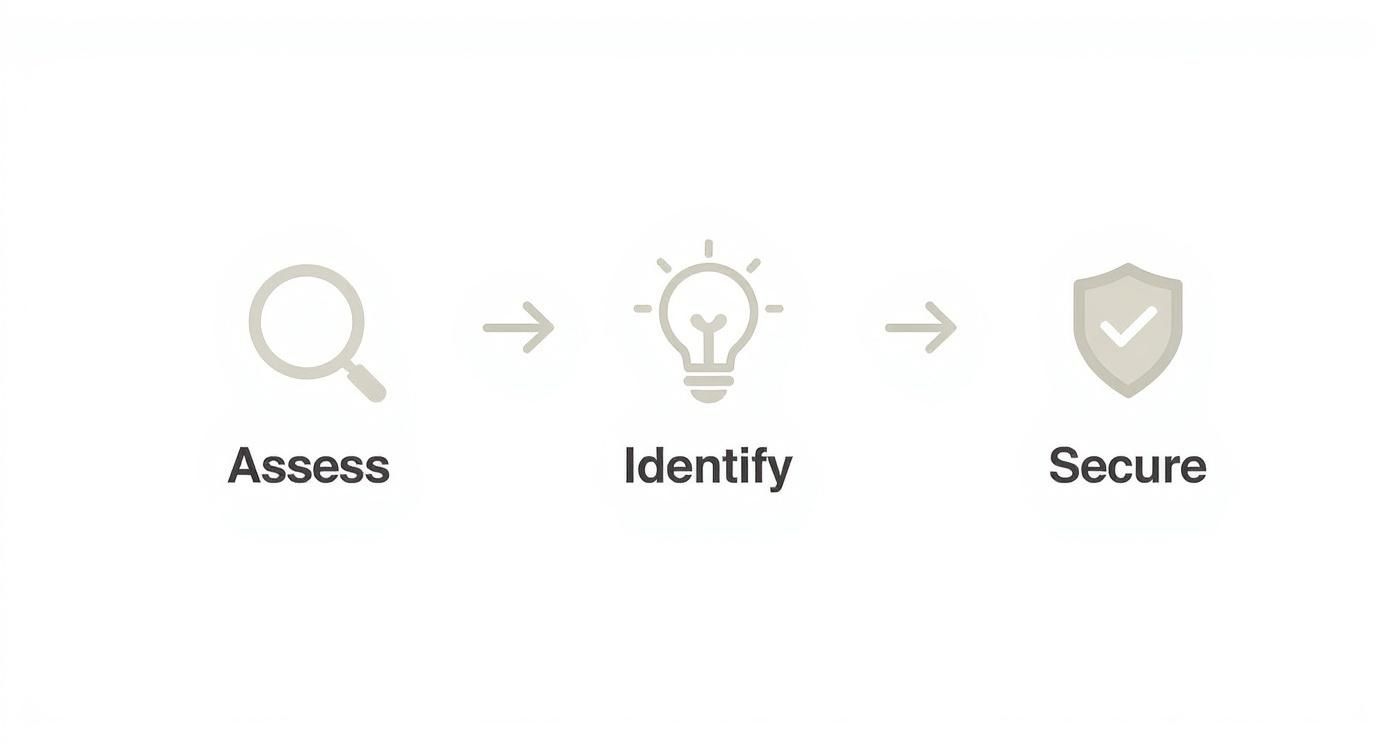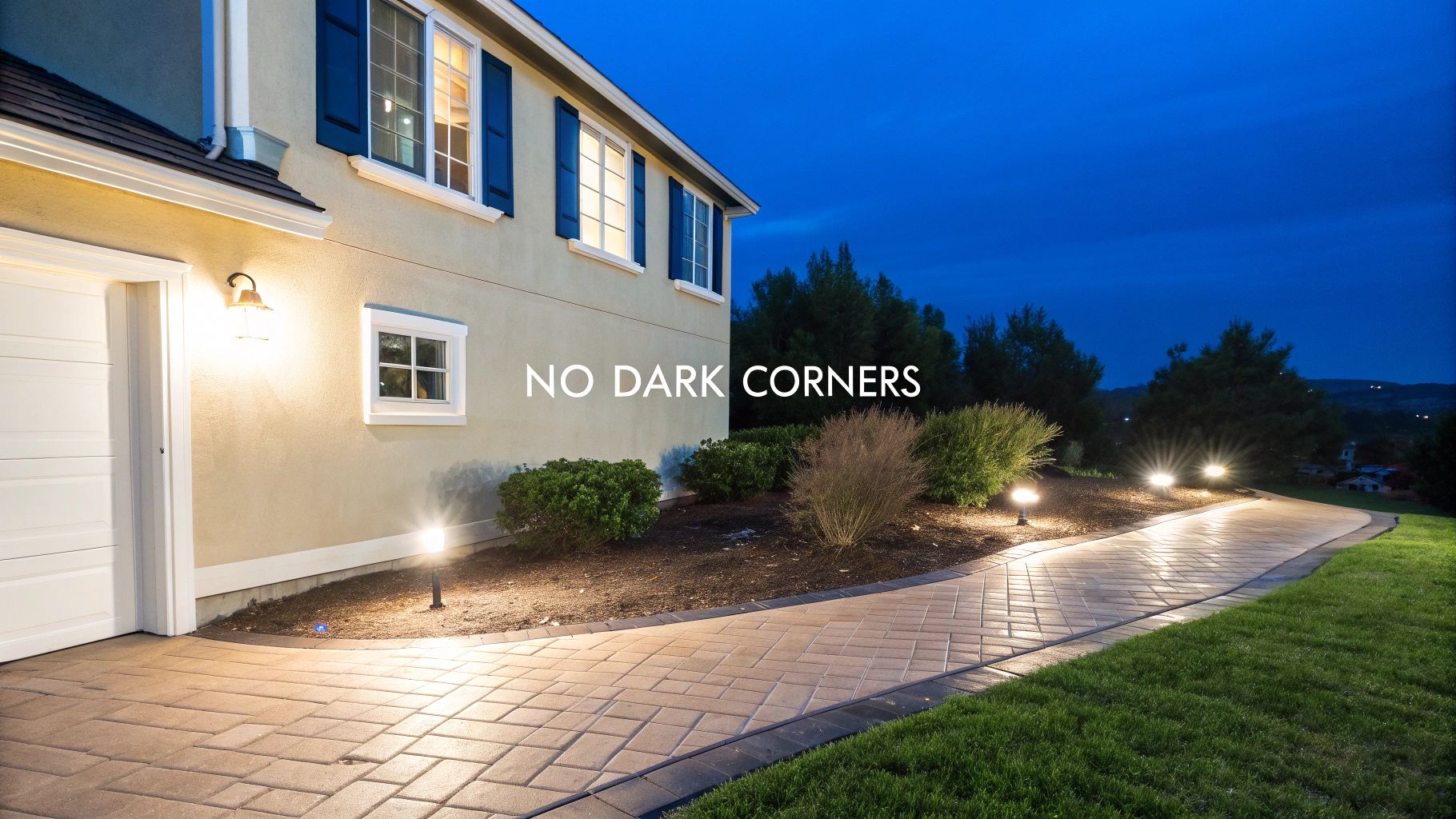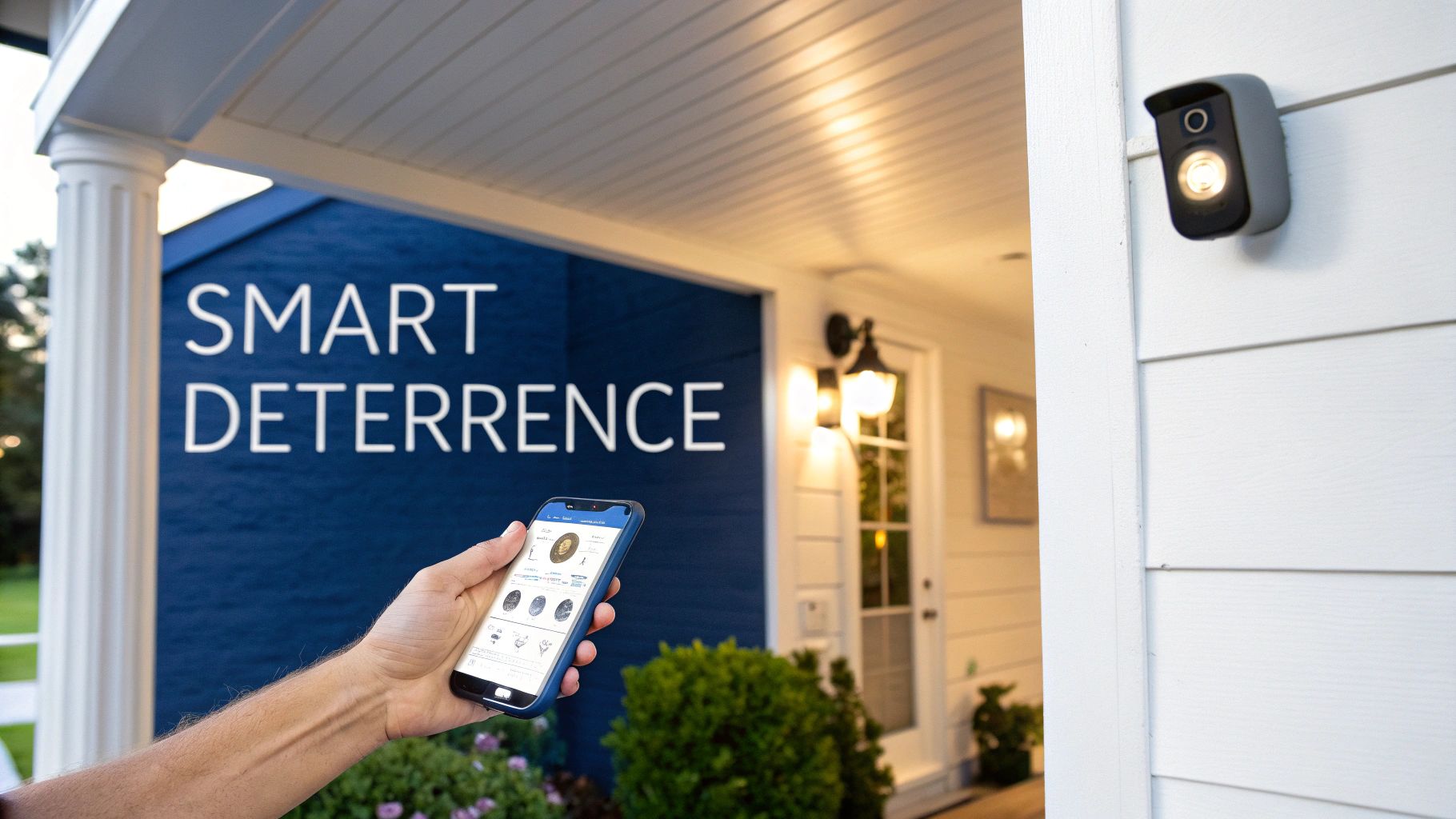How to Prevent Home Burglary: 7 Proven Tips for Safer Living
To stop a burglary before it even starts, you have to learn to think like the person trying to break in. The best defense is seeing your home through their eyes, spotting the weaknesses they're looking for, and fixing them first.
It's all about identifying the easy access points, signs that nobody's home, and even the potential tools an opportunist might find in your own yard. By finding these vulnerabilities yourself, you can build a layered defense long before a real threat shows up.
Adopting a Burglar's Mindset to Spot Weaknesses
You see your home as a place of comfort and familiarity. An intruder sees it as a collection of opportunities and weaknesses. The first step in any real security plan is to walk your own property with the critical eye of a burglar, looking for the gaps you've probably ignored for years.
This isn't about being paranoid; it's about being practical. Burglars are not looking for a challenge. They want the path of least resistance—a house that looks empty, offers hidden entry points, and provides a quick getaway. Your job is to systematically take that ideal scenario off the table.
The Casing Process: What Intruders See
Burglars often "case" a neighborhood before they make a move, and their process is brutally simple. They are scanning for specific signals that scream "easy target." Your own audit should look for these exact same signs.
Start from the street and work your way in, just like they would.
- Signs of Vacancy: Is your mailbox stuffed with mail and flyers? Are packages piling up on the porch? These are dead giveaways that no one's around. Even keeping all your curtains drawn tight during the day can signal an empty house instead of a private one.
- Poor Landscaping and Maintenance: Overgrown bushes and trees are a burglar's best friend, especially when they're right next to windows and doors. They provide perfect cover from neighbors and passing cars. A neglected lawn can also hint that your security might be just as lax.
- Visible Valuables: Can someone peek through a window and see a new laptop on the dining table or your car keys sitting by the door? You're essentially window shopping for a thief.
A study of convicted burglars revealed that most will skip a house if they see signs of a dog, a monitored alarm system, or neighbors who are clearly paying attention. This just goes to show how powerful visible deterrents really are.
Conducting Your Own Property Walk-Through
Now it’s time to get your hands dirty. Grab a notepad and walk the entire perimeter of your property, but this time, analyze everything from the perspective of someone trying to get in.
Ask yourself these pointed questions:
- Where could I hide? Look for those deep shadows next to the house, thick shrubs under windows, or unlit side yards. These are the spots where someone could spend time working on a lock or window completely unseen.
- What could I use to break in? That unsecured ladder against the garage, the heavy garden tools in your unlocked shed, or even a large rock from your flowerbed can all become burglary tools. Always secure anything that could be used to defeat your own security.
- How would I get in? Go around and physically test your own doors and windows. Is the lock on the back window flimsy? Can the sliding glass door be jiggled and lifted off its track? You’ll likely be surprised at what you find.
By performing this self-audit, you're no longer just a homeowner; you're your own security consultant. Understanding these issues is the most important first step. To go deeper, you can learn more about the 7 signs your home is a target for burglars and get more insight into what makes a property attractive to criminals. This proactive check-up is the foundation for every other security measure you'll put in place, from better locks to a sophisticated alarm system.
Hardening Your Doors and Windows Against Forced Entry
Forget the Hollywood image of a cat burglar bypassing lasers. The reality of most home break-ins is far more brutal and straightforward—it’s about brute force. Intruders target the weakest points, and understanding this is the key to stopping them before they start.
The numbers don't lie. FBI data paints a clear picture: a staggering 79% of burglaries happen through doors and first-floor windows. Burglars aren't wasting time picking complicated locks; they're kicking in doors and smashing glass. In fact, an incredible 34% of burglars simply walk through the front door, making it the most common entry point by far. You can see a full breakdown of these burglary statistics on getsafeandsound.com if you want to dig deeper.
This infographic lays out the basic cycle: assess your weak spots, identify the right fixes, and secure them. It's a continuous loop, not a one-and-done job.

This methodical approach—assess, identify, secure—is the most effective way to protect your home.
Your Front Door Is Your First Line of Defense
Your front door needs to be a real barrier, not just a suggestion. Many standard-issue doors, especially the hollow-core types that should only be used inside, can be shattered with a single well-aimed kick. Making that door a serious obstacle is probably the single most important physical upgrade you can make.
The material of the door itself is non-negotiable. If you have a hollow-core door on any exterior entrance, your first job is to replace it.
- Solid-Core Wood: These are dense and offer real resistance to force.
- Reinforced Steel: For maximum security against physical attacks, a steel door is the top choice.
- Fiberglass: Modern fiberglass doors can be reinforced to provide excellent security and durability.
But a strong door is only as good as its hardware. A cheap lock on a great door is a waste of money. You need a high-quality, heavy-duty deadbolt with at least a 1-inch throw bolt. That extra length allows the bolt to embed deeper into the door frame, making it exponentially harder to pry or kick open. Of course, knowing how to answer the door is just as important; check out these front door safety strategies and using home security features to keep yourself safe.
Reinforcing the Door Frame: The Unsung Hero
Here’s a detail almost everyone misses: a strong door and a great deadbolt are useless if the frame they're attached to is flimsy. The small metal plate your deadbolt slides into—the strike plate—is often secured with tiny half-inch screws that only grip the thin doorjamb.
Pro Tip: The single most effective, low-cost security upgrade for any door is to replace the factory-installed strike plate screws with 3-inch-long hardened steel screws. These longer screws will bypass the weak doorjamb and anchor the strike plate directly into the solid wood stud of your home's wall frame.
This simple, five-minute fix transforms your door's resistance. Instead of relying on a thin piece of decorative wood, you're leveraging the structural integrity of your entire house. It’s often the difference between a door that holds and one that flies open.
Securing Vulnerable Windows and Sliding Doors
Once doors are hardened, burglars look to ground-floor windows and sliding glass doors. Those large panes of glass and flimsy factory locks are an open invitation for a fast entry.
For standard windows, adding secondary locks is a smart, easy win. You can use window pins, Charley bars, or other simple aftermarket locks. These devices physically stop the window from being opened, even if the main latch is broken.
Another fantastic tool is shatter-resistant security film. This clear film is applied directly to the glass, holding the pane together even when it's shattered. A burglar can crack the window, but they won't get a clean opening to climb through. Instead, they'll create a lot of noise and delay—two things they absolutely hate.
Sliding glass doors are notoriously weak. Their standard latches are easily defeated, and sometimes the doors can be lifted right off their tracks.
- Security Bar: The simplest fix is often the best. Place a heavy-duty security bar or even a sturdy wooden dowel in the bottom track. This physically blocks the door from sliding open.
- Anti-Lift Devices: Install a few screws or specialized devices into the top track. This prevents a would-be intruder from lifting the door panel out of its frame.
By systematically hardening each of these primary entry points, you completely change the risk calculation for an intruder. Your home goes from being an easy target to a difficult, noisy, and high-risk proposition—and that's the core of effective burglary prevention.
Using Strategic Lighting to Eliminate Cover
Burglars love the dark. It’s their single greatest advantage, giving them a cloak of invisibility to scout your property, test a window, or work on a lock without being seen by neighbors or passing cars. An effective home security plan weaponizes light to strip that advantage away.
With a smart, multi-layered lighting strategy, you can turn your property from a shadowy hideout into an exposed, high-risk target for any would-be intruder. The goal isn’t just to blast your yard with light; it's to be strategic. You want to eliminate every potential hiding spot and create an immediate, startling response to movement in sensitive areas. This approach makes a burglar feel vulnerable the second they set foot on your property.

Floodlights: The First Line of Shock and Awe
Motion-activated floodlights are the heavy hitters in your lighting arsenal. Their job is simple: startle an intruder with a sudden, intense blast of light that puts them directly in the spotlight. When a powerful light unexpectedly floods a dark area, the natural human reaction is to freeze or flee—and that’s exactly what you want.
Placement is everything. You need to cover the areas a burglar is most likely to use for concealment or approach.
- Corners of Your Home: Mount floodlights under the eaves at each corner, angled to wash the side yards and the rear of the property in light. This move alone eliminates the deep shadows where someone could lurk undetected.
- Above Entry Points: A floodlight positioned over the garage door, back door, and any side entrances ensures anyone approaching these key vulnerabilities is instantly illuminated.
- Detached Structures: Don’t forget about sheds or detached garages. These are common secondary targets, so a dedicated motion light covering their approach path is a must.
When you're buying the lights, go for brighter LED models. They’re far more energy-efficient and produce a clean, powerful light that’s much more effective than old-school halogen bulbs. Just be sure to set the motion sensors so they're sensitive enough to detect a person but not so twitchy that they’re triggered by every passing cat.
Landscape Lighting: Ambiance Meets Security
While floodlights provide a powerful, reactive defense, low-voltage landscape lighting adds a constant, more subtle layer of security. This type of lighting is brilliant because it serves a dual purpose: it boosts your home’s curb appeal while methodically erasing the very hiding spots burglars depend on.
Think of it as painting with light to remove shadows.
Key Takeaway: The most vulnerable parts of your property are often the unlit pathways along the side of the house, the dark patches under first-floor windows, and the shadowy corners around your back patio. Strategic landscape lighting makes these areas feel exposed and unsafe for intruders.
Focus your landscape lights on these key areas:
- Pathways and Walkways: Uplighting along the paths leading to your front and back doors ensures no one can approach unseen.
- Beneath Windows: Place small, low-profile lights aimed at the base of your home under ground-floor windows. This simple trick eliminates a classic hiding spot.
- Highlighting Trees and Shrubs: Illuminating larger plants can be beautiful, but be careful not to create new shadows behind them. The goal is to wash the area with gentle light, not create dramatic, dark contrasts where someone could hide.
Defensive Landscaping: A Natural Barrier
Finally, you can turn your landscaping itself into a physical security barrier. This concept, known as defensive landscaping, involves using specific types of plants to create a painful and difficult-to-navigate obstacle, especially under vulnerable first-floor windows.
Imagine a burglar trying to pry open a window while being jabbed by sharp thorns. It's a noisy, painful, and highly effective deterrent that works 24/7 without needing any electricity.
Here are a few excellent choices for defensive plants:
- Barberry: A dense, thorny shrub that forms an impassable hedge.
- Holly: Features sharp, spiny leaves that are extremely unpleasant to push through.
- Climbing Roses: They're beautiful to look at but armed with formidable thorns, making them perfect for training up a trellis near a wall or window.
By combining the sudden shock of motion-activated floodlights, the constant visibility from landscape lighting, and the physical deterrence of defensive planting, you create a layered system. This strategy makes your home’s perimeter so well-lit and difficult to approach that most burglars will simply decide it’s not worth the risk and move on to an easier, darker target.
Leveraging Smart Technology for Active Deterrence
Physical barriers are your home's last line of defense, but modern smart technology can turn that defense from passive to active. It’s a complete game-changer. Today’s connected devices do more than just record a crime; they work together to actively scare off intruders, send you instant alerts, and create a convincing illusion that someone's always home, making your house a much harder target.
Building a smart, integrated system isn't about buying every gadget you see online. It’s about strategically layering different technologies—cameras, alarms, lights, and locks—so they act as a single, intelligent unit to prevent a break-in before it ever happens.

Smart Video Surveillance Best Practices
Security cameras are one of the most powerful deterrents out there, but their effectiveness depends entirely on smart placement and having a clear purpose for each one. The goal is to cover every likely entry point and approach path without creating blind spots or, just as importantly, invading your family's personal privacy.
Here’s how to think about the different types of cameras and their roles:
- Doorbell Cameras: Think of this as your digital gatekeeper. It doesn't just record who comes to your door; it lets you talk to them from anywhere using your smartphone. This one device is fantastic for scaring off package thieves and burglars who ring the bell first to see if you're home.
- Floodlight Cameras: These combine the shock of a sudden, bright floodlight with HD video. They are absolutely perfect for driveways, backyards, and dark side yards. When a trespasser is suddenly blasted with light and knows they're on camera, the psychological pressure to get out of there is immense.
- Discreet Outdoor Cameras: Place these under the eaves of your roof to watch over secondary spots like ground-floor windows, back gates, or a side door. Often, their mere presence is enough to convince a would-be intruder to move on.
- Indoor Cameras: Use these sparingly and strategically. They work best for monitoring large common areas like a living room or main hallway to track an intruder's movement if they actually manage to get inside. A critical rule: Never place them in private spaces like bedrooms or bathrooms.
A quick comparison of these technologies shows how each contributes to a layered surveillance strategy.
Smart Security Device Comparison
Choosing the right devices and placing them correctly is key to building an effective digital defense. This table breaks down the most common smart security tools to help you decide where to invest first.
| Device Type | Primary Function | Best Placement | Key Benefit |
|---|---|---|---|
| Video Doorbell | Identify and interact with visitors | Front door | Deters package theft and "knock-knock" burglars |
| Floodlight Camera | Detect motion, illuminate, and record | Driveway, backyard, side of house | High-impact visual and psychological deterrent |
| Outdoor Camera | Discreetly monitor specific zones | Under eaves, watching gates/windows | Provides constant visual coverage of key areas |
| Indoor Camera | Monitor activity inside the home | Main living areas, hallways | Confirms interior breach and tracks movement |
| Smart Lock | Control and log door access remotely | All exterior doors | Eliminates physical keys and creates an access audit trail |
| Smart Lighting | Automate lighting to simulate occupancy | Throughout the house (interior/exterior) | Creates a believable "someone is home" illusion |
By combining these devices, you create a system where each component supports the others, providing a much stronger defense than any single gadget could on its own.
The Power of a Professionally Monitored System
Sure, DIY cameras and sensors are great for sending alerts to your phone. But what happens if you're in a meeting, on a plane, or just don't see the notification in time? That's where a professionally monitored alarm system becomes absolutely essential. It provides the crucial link to immediate, real-world help.
When a sensor trips, the signal doesn't just ping your phone—it goes to a 24/7 monitoring center staffed by trained professionals ready to act.
A landmark study from the University of North Carolina found that about 60% of convicted burglars admitted they would steer clear of a home if they knew it had a security system. Professional monitoring amplifies that deterrent effect significantly.
This isn’t just about convenience; it's about a guaranteed response. A monitoring center operator can verify the alarm, often through live audio or video, and dispatch police, fire, or medical services for you. That rapid, confirmed response is something self-monitored systems just can't match. If you're weighing the options, understanding why a security system with professional monitoring beats a DIY approach makes the value crystal clear.
Creating the Illusion of an Occupied Home
One of the oldest tricks in the book is still one of the best: make your house look like someone's home, especially when you’re not. Smart home automation makes this easier and far more convincing than old-school plug-in timers.
You can set up your home to mimic your family's daily routine with incredible realism:
- Smart Lighting Schedules: Program different lights to turn on and off at varied, natural-looking times. Have the living room lamp come on at dusk, the kitchen lights an hour later, and then have them all shut off as the upstairs bedroom lights turn on.
- Automated Entertainment: Hook up a TV or radio to a smart plug. Scheduling it to turn on for a couple of hours in the evening adds another believable layer of sound and flickering light that strongly suggests someone is home watching a show.
- Smart Lock Control: Give temporary access to a pet sitter or house cleaner with a unique code, and then instantly revoke it the moment they're done. You keep total control and have a digital log of every time the door was used, all from your phone.
By weaving these smart technologies together, you're not just hardening your home against an attack—you're building a proactive defense network that convinces burglars to skip your house and look for an easier target from the very start.
Building a Neighborhood Alliance for Greater Security
Your home’s security doesn’t stop at your property line. The most powerful, yet often overlooked, asset in your security plan is right next door: your neighbors.
A connected, observant community creates an environment where criminals feel watched and exposed. An intruder's biggest fear is being noticed. When neighbors know each other, they develop an intuitive baseline for what’s normal on the street. An unfamiliar car lingering for too long or a stranger walking up a driveway suddenly stands out.
This collective vigilance transforms a quiet street into an active security network, making it one of the most effective deterrents available.
Starting a Neighborhood Watch
Joining or starting a formal Neighborhood Watch program is a fantastic way to give structure to this community effort. These programs aren't about citizens policing the streets; they're about being organized, informed, and officially connected with local law enforcement.
The first step is often the simplest one. Just start talking. Gauge interest with a few neighbors you already know. You might be surprised how many share your security concerns and are eager to team up.
Once you have a small group, you can take more concrete actions:
- Establish Communication: A simple group text or WhatsApp chat is a game-changer. It allows for instant alerts about suspicious activity, like a "porch pirate" making their way down the block or an unknown vehicle circling the area.
- Share Contact Information: Create a voluntary contact list with phone numbers and email addresses. This is invaluable in an emergency, whether it's a potential break-in or a burst water pipe when someone is out of town.
- Designate Block Captains: Having a point person for each small section of the neighborhood helps keep communication organized and ensures information gets distributed efficiently.
Key Insight: A connected neighborhood offers practical security benefits that technology alone can't provide. A neighbor can pick up your overflowing mail while you're on vacation or hold onto a package delivered to your porch—removing key signals that tell a burglar your home is an easy target.
The Power of Simple Cooperation
You don’t need a formal, structured program to reap the benefits of a neighborhood alliance. The core principle is simply looking out for one another. This can start with small, friendly gestures that build trust and familiarity over time.
For instance, if you're going away for the weekend, let your trusted next-door neighbor know. Ask them to keep an eye out, maybe park a car in your driveway occasionally, and pull your trash bins in after pickup. These small actions create a powerful illusion of occupancy that can make a burglar skip your house entirely.
Building these relationships means that when something is truly wrong, you have a support system ready to act. That neighbor who knows your routine is far more likely to notice a broken window or an open garage door and make a call. This human element—the simple act of caring and paying attention—is a layer of security that no camera or alarm can ever fully replicate.
It’s about creating a community where criminals know they can’t operate without being seen.
Common Questions About Preventing Home Burglary
Even after you've got a solid security plan, practical questions always pop up. Getting straight answers is key to feeling confident in the choices you make to protect your home. Here are some of the most common things we hear from homeowners across Los Angeles.
Getting into the specifics of why certain security measures work helps you focus your time and money where they'll make the biggest difference.
Do Security System Signs and Stickers Actually Work?
Yes, they’re surprisingly effective as a first line of defense. In interviews, many convicted burglars admit they deliberately skip houses that display signs from professional security companies. Just seeing that sign or sticker instantly makes them think twice.
It tells them there's a good chance of silent alarms, crystal-clear video evidence, and a quick response from law enforcement or a private patrol. A sign isn't a complete solution on its own, of course, but it’s a cheap and easy way to make your home look like more trouble than it's worth from the street. It encourages them to move on to an easier target before they even set foot on your property.
A well-known study from the University of North Carolina at Charlotte found that more than 80% of convicted burglars would try to figure out if a home had an alarm system before attempting a break-in. Signs and stickers are the most obvious clue they look for.
This really drives home the psychological power of showing you're protected. It's a simple move that plays directly into a burglar's desire for a low-risk, no-hassle job.
What’s the Most Important Security Upgrade on a Tight Budget?
Without a doubt, beefing up your front door gives you the best bang for your buck. Since the front door is the #1 entry point for forced break-ins, making it stronger is the most direct and affordable way to fix your biggest weak spot.
The single best thing you can do is replace the short, flimsy screws in your door's strike plate and hinges. Swap them out for 3-inch-long hardened steel screws.
This simple change anchors your door frame directly into the structural studs of your house, not just the thin, decorative wood of the doorjamb. A kick can easily split a doorjamb, but it can't break the actual frame of your house. This fix, which costs less than lunch, massively improves your defense against brute-force attacks.
Is a Barking Dog Enough to Deter Burglars?
A barking dog is a fantastic deterrent, but it should never be your only defense. The sudden noise and attention a dog brings are exactly what most burglars want to avoid. Many opportunistic thieves will just skip a house with a loud dog and move on.
But a more determined intruder might know tricks to distract, quiet, or even harm a dog. Relying only on your pet puts them in danger and leaves your home wide open if the burglar succeeds.
Your dog is one very effective layer in a bigger security plan. Their natural alertness needs to be backed up by other critical layers that all work together.
- Strong Physical Barriers: This means solid doors with reinforced frames and high-quality deadbolts.
- Secured Windows: Make sure all ground-floor windows have secondary locks or security film applied.
- Monitored Alarm System: A professional alarm guarantees a response, even when you're not home.
When you combine your dog's instincts with solid physical and electronic security, you create a powerful defense that truly has you covered.
For a truly integrated security solution that combines advanced technology with rapid local response, trust the experts at ACS Security. Our team provides Los Angeles homeowners with professionally designed and monitored systems tailored to your property's unique needs. Discover the peace of mind that comes with concierge-level protection by visiting https://www.acssecurity.com to learn more.
Article created using Outrank



